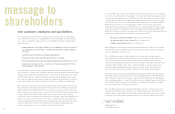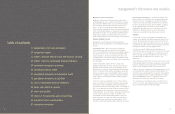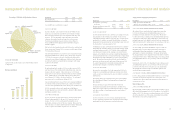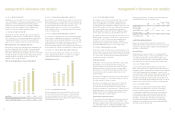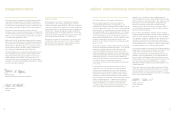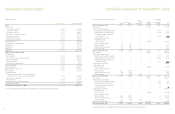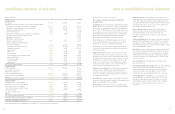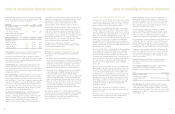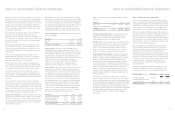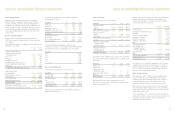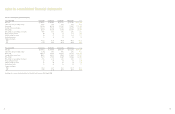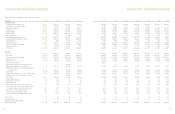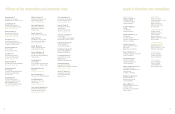Nordstrom 2004 Annual Report Download - page 19
Download and view the complete annual report
Please find page 19 of the 2004 Nordstrom annual report below. You can navigate through the pages in the report by either clicking on the pages listed below, or by using the keyword search tool below to find specific information within the annual report.
new receivables are generated and old receivables are retired (through
payments received, charge-offs, or credits from merchandise returns).
The trusts issue securities that are backed by the receivables.
Certain of these securities or “beneficial interests” are sold to
third-party investors and the remaining securities are issued to us.
Under the terms of the trust agreements, we may be required to fund
certain amounts upon the occurrence of specific events. Both of our
credit card securitization agreements set a maximum percentage of
receivables that can be associated with various receivable categories,
such as employee or foreign receivables. As of January 29, 2005, these
maximums were exceeded by $166. It is possible that we may be
required to repurchase these receivables. Aside from these instances,
we do not believe any additional funding will be required.
The private label securitizations are accounted for as a secured
borrowing (on-balance sheet) while the VISA securitization qualifies
for sale treatment (off-balance sheet).
NORDSTROM PRIVATE LABEL RECEIVABLES (ON-BALANCE SHEET)
We transfer these receivables to a third-party trust (“Private Label
Trust”) that issues two Nordstrom private label receivable backed
securitizations:
•In November 2001, the Private Label Trust issued $300,000 of
Class A notes to third party investors (“Private Label Securitization”).
The Class A notes bear a fixed coupon rate of 4.82% and mature in
October 2006. The Class A notes are included in long-term debt
and the Nordstrom private label card receivables, which serve as
collateral for the debt, are included in accounts receivable, net.
•In December 2001, a variable funding note was established that
is also collateralized by the Nordstrom private label receivables
(“Private Label VFN”). The Private Label VFN was initially
established with a facility limit of $200,000 with an annual renewal
subject to agreement by all parties. In May 2004, we renewed the
Private Label VFN and reduced the capacity by $50,000 to $150,000.
Interest on the Private Label VFN varies based on the actual cost of
commercial paper plus specified fees. We also pay a commitment
fee for the Private Label VFN based on the amount of the
commitment. No borrowings were made under the Private Label
VFN in 2004 or 2003.
Total principal receivables of the securitized private label portfolio at
the end of 2004 and 2003 were approximately $566,967 and $584,828,
and receivables more than 30 days past due were approximately
$13,099 and $14,910. Net charged off receivables for 2004, 2003
and 2002 were $25,370, $28,703, and $29,555.
notes to consolidated financial statements
The following table illustrates the effect on net earnings and earnings
per share if we had applied the fair value recognition provisions of SFAS
No. 123, “Accounting for Stock-Based Compensation.”
Fiscal year 2004 2003 2002
Net earnings, as reported $393,450 $242,841 $90,224
Add: stock-based compensation
expense included in reported
net earnings, net of tax 4,894 9,898 2,240
Deduct: stock-based compensation
expense determined under fair
value, net of tax (25,001) (30,154) (22,834)
Pro forma net earnings $373,343 $222,585 $69,630
Earnings per share:
Basic–as reported $2.82 $1.78 $0.67
Diluted–as reported $2.77 $1.76 $0.66
Basic–pro forma $2.68 $1.63 $0.52
Diluted–pro forma $2.62 $1.62 $0.51
Cash Equivalents: Cash equivalents are short-term investments with
a maturity of three months or less from the date of purchase.
As of the end of 2004 and 2003, we have restricted cash of $6,886
and $7,140 included in other long term assets. The restricted cash is
held in a trust for use by our Supplemental Executive Retirement Plan
and Deferred Compensation Plans.
Cash Management: Our cash management system provides for the
reimbursement of all major bank disbursement accounts on a daily
basis. Accounts payable at the end of 2004 and 2003 includes $86,725
and $89,404 of checks not yet presented for payment drawn in excess of
our bank deposit balances.
Short-term Investments: Short-term investments consist of auction
rate securities classified as available-for-sale. Auction rate securities
are high-quality variable rate bonds whose interest rate is periodically
reset, typically every 7, 28, or 35 days. However, the underlying security
can have a duration from 15 to 30 years. Our auction rate securities
are stated at cost, which approximates fair value, and therefore there
were no unrealized gains or losses related to these securities included
in accumulated other comprehensive earnings. The cost of securities
sold was based on the specific identification method.
Securitization of Accounts Receivable: We offer Nordstrom private
label cards and co-branded Nordstrom VISA credit cards to our
customers. Substantially all of the receivables related to both credit
cards are securitized. Under our credit card securitizations, the
receivables are transferred to third-party trusts on a daily basis.
The balance of the receivables transferred to the trusts fluctuates as
notes to consolidated financial statements
CO-BRANDED NORDSTROM VISA RECEIVABLES (OFF-BALANCE SHEET)
In order to enhance our cost-effective capital sources, we have in place
a securitized asset structure. This allows us to reduce our investment
in the co-branded Nordstrom VISA credit card receivables, so we can
deploy our capital resources to greater-value opportunities.
We transfer our co-branded Nordstrom VISA credit card receivables to
a third-party trust (“VISA Trust”) that issues VISA receivable backed
securities. In May 2002, the VISA Trust issued $200,000 of certificated
Class A and Class B notes to third-party investors (“2002 Class A & B
Notes”) and a certificated, subordinate Class C note to us. The
receivables transferred to the VISA Trust exceeded the face value of the
issued notes. This excess created a certificated, non-subordinated
asset called the Transferor’s Interest, which was also conveyed to us.
In addition, we hold a non-certificated Interest Only Strip, which results
when the estimated value of projected cash inflows related to the notes
exceeds the projected cash outflows.
We do not record the $200,000 in debt related to the VISA securitization
or the receivables transferred to the VISA Trust on our consolidated
financial statements. However, we do hold the 2002 Class C note,
the Transferor’s Interest and the Interest Only Strip. These amounts
are included in the consolidated balance sheets as investment in asset
backed securities and accounted for as investments in “available-for-
sale” debt securities. As such, we record the investment in asset
backed securities at its estimated fair value in our consolidated
balance sheets.
We recognize gains or losses on the sale of the co-branded Nordstrom
VISA receivables to the VISA Trust based on the difference between the
face value of the receivables sold and the estimated fair value of the
assets created in the securitization process. The receivables sold to
the VISA Trust are then allocated between the various interests in the
VISA Trust based on those interests’ relative fair market values. The
fair values of the assets are calculated as the present value of their
expected future cash flows. The unrealized gains and losses, as well
as any adjustments to fair value of the investment in asset backed
securities, are recorded as a component of accumulated other
comprehensive earnings.
In addition, we record interest income related to the investment
in asset backed securities based upon their carrying value and their
internal rate of returns.
The gain on sales of receivables and the interest income earned on the
beneficial interests are included in other income including finance
charges, net in our consolidated statements of earnings.
Accounts Receivable: Accounts receivable consist primarily of our
Nordstrom private label receivables that serve as collateral for our
Private Label Securitization. We record the face value of the principal,
plus any assessed finance charges, late fees, or cash advance fees.
We recognize these charges and fees when earned and accrue for any
earned but not yet billed charges and fees.
We report accounts receivable net of an allowance for doubtful
accounts. Our allowance for doubtful accounts represents our best
estimate of the losses inherent in our customer accounts receivable
based on several factors, including historical trends of aging of
accounts, write-off experience and expectations of future performance.
We recognize finance charges on delinquent accounts until the account
is written off or when an account is placed into a debt management
program. Payments received for these accounts are recorded in the
same manner as other accounts. Our approach for resuming accrual
of interest on these accounts is made on an account by account basis.
Delinquent accounts are written off when they are determined to be
uncollectible, usually after the passage of 151 days without receiving
a full scheduled monthly payment. Accounts are written off sooner
in the event of customer bankruptcy or other circumstances making
further collection unlikely.
Merchandise Inventories: Merchandise inventories are valued
at the lower of cost or market, using the retail method (first-in,
first-out basis).
Land, Buildings and Equipment: Depreciation is computed using
a combination of accelerated and straight-line methods.
Estimated useful lives by major asset category are as follows:
Asset Life (in years)
Buildings and improvements 5-40
Store fixtures and equipment 3-15
Leasehold improvements Shorter of life of lease or asset life
Software 3-7
Asset Impairment: We review our intangibles and other long-lived
assets annually for impairment or when circumstances indicate the
carrying value of these assets may not be recoverable. The goodwill
and tradename associated with our Façonnable business are our largest
impairment risk. See Note 2 for our impairment evaluation of goodwill
and intangible assets.
35
34


